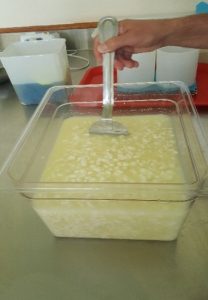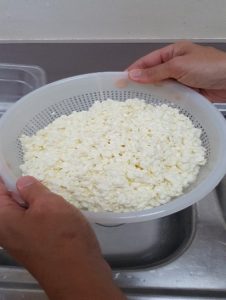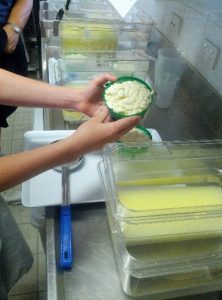Just prior to hooping curds, the curds are in the ‘curds and whey’. There are two distinct situations in the cheese vat:
- whey

- semi‑solid curd particles
The degree of whey drainage from the curd prior to hooping will affect the flavour and texture of the finished cheese.
- After cutting the curds, syneresis or drainage of whey from the curd causes the curd particles to progressively become smaller with the expulsion of whey from the curd.
- The starter cultures are trapped in the casein gel and begin to ferment the lactose to lactic acid and, therefore, lower the pH of the curd particle. The rate of acid production is greater within the curd particle because it is here where the greatest majority of starter bacteria are trapped. The level of lactic acid in the curd is higher than that in the whey. As lactose in the curd particle is used up, further lactose from the whey diffuses back into the curd particles via the curd membrane. At the same time, lactic acid diffuses from the curd particle into the whey. There is a continuous transfer of lactose into the curd particle and lactic acid out of the curd particle. All the time, ensuring there is sufficient lactose in the curd particle for fermentation by the starter cultures. It is for these reasons that it is vitally important to carefully control the curd ‘in the whey’.
- The ultimate pH of the cheese is almost entirely dependent on the levels of lactic acid and lactose present in the curd when the whey is drained. At hooping or whey drainage, there is essentially no diffusion of fresh whey back into the curd particle.
 The stage and method of whey removal will have very important effects on the cheese produced. Early drainage of a soft curd is usually used in making soft cheese types. Some traditional Camembert only requires the ladling of coagulated curd directly into the moulds, with no cutting, stirring or cooking. Some feta styles are placed in drainage hoops or trays as soon as the curd has been cut. Blue Vein requires a short period of agitation and curd firming before it is placed in perforated hoops for draining and matting.
The stage and method of whey removal will have very important effects on the cheese produced. Early drainage of a soft curd is usually used in making soft cheese types. Some traditional Camembert only requires the ladling of coagulated curd directly into the moulds, with no cutting, stirring or cooking. Some feta styles are placed in drainage hoops or trays as soon as the curd has been cut. Blue Vein requires a short period of agitation and curd firming before it is placed in perforated hoops for draining and matting.
Late draining after prolonged agitation, cooking and acid development characterises the making of most firm and hard cheese (for example, Cheddar, Parmesan, Comte).
For small and large eye-type cheese, whey drainage is completed only after the curd has been compressed under the whey. This is necessary to achieve a close-textured cheese with no mechanical openings due to the inclusion of air during drainage and pressing. Any mechanical openings in eye-type cheese will cause uneven and irregular eye formation, a serious appearance defect.
 Some cheeses have a step just prior to hooping where water is added to the whey to dilute the acid within the curd particle (for example Edam and Gouda)
Some cheeses have a step just prior to hooping where water is added to the whey to dilute the acid within the curd particle (for example Edam and Gouda)
Bag draining, such as quark and cream cheese without hooping and little or no pressing, is applied to cheese with no real fused curd structure or shape.



